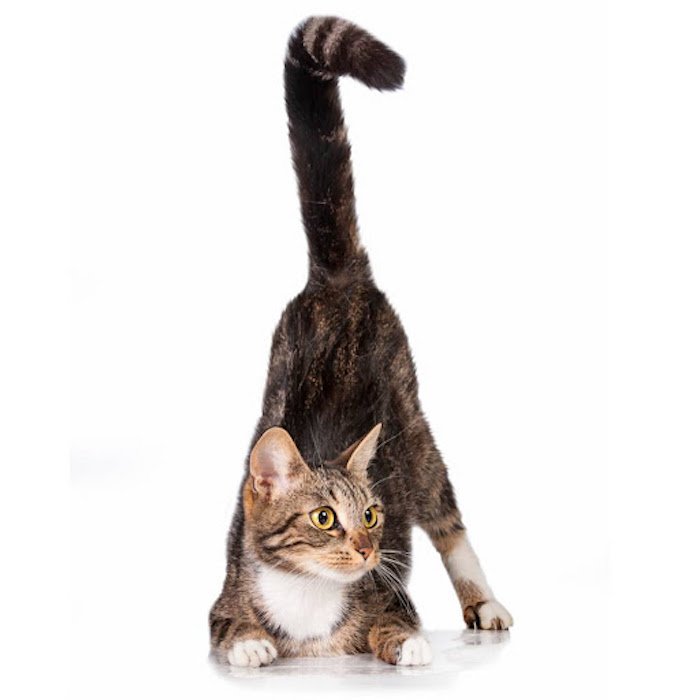
Have you ever watched your cat switch their tail and wondered if your cat has bones in the said tail? The answer is yes. Cats do have bones in their tails.
A cat’s tail is made up of vertebrae and is a continuation of their backbone. Different breeds of cats have varying numbers of these bones, making up their tails. These tiny bones connect with ligaments and muscles, allowing the tail to move in various ways.
Cats are agile and find themselves in some tricky places. They need their tail to help counterbalance their acrobatics and maintain their footing.
A cat can use their tail to communicate with other cats or humans. A raised tail may show happiness, but a tucked tail may show fear.
What Are Cat Tails Made Of?
Cat’s tails are made of vertebrae, the same kind of bones that make up the backbone. These vertebrae extend all the way to the end of the tail, getting smaller as they get to the tip.
These tailbones are held together by ligaments, tendons, and muscles, which support the tail. Because of the many small bones, with tiny spaces between them, makes cat tails quite flexible. This allows cats to move their tails in amazing directions.
How Many Bones In A Cat’s Tail?
Not all cat tails have the same number of bones. The number can vary with the breed or individual cat. However, most cats have between nineteen and twenty-one bones. Nearly ten percent of a cat’s total bones are in their tails.
Manx cats are known for their short and sometimes non-existent tail are the most dramatic example of the number of bones in a cat’s tail.
Is There Cartilage In Cat’s Tails?
You mostly find cartilage in your ear, nose, and joints. It’s a prevalent type of connective tissue found throughout the body, including cats’ tails. This is why cats have so much flexibility in their tail movements.

Can Cats Feel Pain In Their Tails?
Yes! While it might seem detached from their body, a cat’s tail is extremely sensitive and contains several nerves extending from the spinal column. These nerves control the precise movements of the tail and the bladder, rear leg, and intestine functions. It can seem that cats are carefree about their tails, but they do care about their tails. A severe injury to a cat’s tail can lead to a range of problems the most concerning is bladder and bowel issues.
Can Cats Live Without Their Tails?
Cats can live without their tails. Some cats aren’t even born with tails. Tails act as counterweights to help our cats balance, but cats can adapt and learn to live without a tail.
Can Cats Control Their Tails?
Cats have complete control of their tails, but some movements may be made involuntarily- or at least without conscious effort. For example, when a cat jumps or weaves through some obstacle, their tail naturally reacts to their movements, helping them balance.
How Long Is A Cat’s Tail?
On average, a domestic cat’s tail is twelve inches long. But what sometimes makes the cat’s tail look so impressive is that most cats measure only eighteen inches without their tail. So, that makes their tail more than half their body length.
There are exceptions to the rule. Some cats may have shorter tails than their body length, but others have extra-long tails. One such cat is a Maine Coon named Cygnus Regulus Powers. He holds the Guinness record for the longest tail at 17.58 inches.
If You Pull A Cat’s Tail, Will It Hurt?
Pulling a cat’s tail will not only cause pain but could also result in a severe or even life-threatening injury. The nerves of the tail branch out from the spinal column controlling critical body functions like defecation, urination, and the hind legs.
A cat with a severe tail pull injury may not be able to hold their tail up and may dribble urine or feces if they’ve lost control of these bodily functions. You may think these injuries can only happen if a person pulls on a cat’s tail, but it can happen if they fight with another animal or even have their tail shut in a door.

Other Injuries To A Cat’s Tail
Abrasions. Superficial scrapes can occur when a cat flicks their tail against a sharp surface or catches their tail under something.
If this happens, you should clean the area with mild soap and warm water. Next, apply antibiotic ointment and bandage the tail with a self-adhering wrap. Avoid wrapping the bandage too tight so you don’t restrict blood flow. Change the bandage and re-apply antibiotic ointment daily. Bitter Apple or a collar (cone) may deter chewing at the bandage.
If there is excessive bleeding, swelling occurs, or the tissue changes color, take your cat to your veterinarian.
Lacerations. More severe than superficial abrasions, lacerations can be deep cuts that expose underlying muscle and bone. Some lacerations are self-inflicted by cats that are nervous, bored, or have other behavior problems. Tail biting may be caused by allergies to fleas or impacted anal glands. Infection can occur in this type of injury, especially with bite wounds. Some lacerations will require stitches.
Fractured Tail. Like any other bone, the vertebrae in the tail can break. A fractured tail can occur if a cat is hit by a car, falls, or has their tail slammed in a door. The location of the fracture on the tail corresponds with how severe the injury is.
A break at the tip of the tail usually heals without any treatment. The healed tail may have a permanent kink or bump on it. An injury involving the tail being crushed can sometimes result in some of the tail being amputated because the injury involves nerve damage.
Nerve damage. The bony vertebrae protect the nerves in the tail, but they can be injured. For example, avulsion injuries may stretch or tear nerves. Avulsion injuries involve the tail being pulled. Tail pull injuries can damage nerves that control urination and defecation.
Muscles Are In A Cat’s Tail
Cats have six different muscles in their tails. These muscles all work together to give cats a considerable range of movements. Of course, these muscles are just part of the picture. The entire system of small bones, muscles, and connective tissue gives cats their unique tail.
Conclusion
Cats have unique tails that they can control when they want, but their tails also work involuntarily when they are climbing and making their way through obstacles. Depending on the breed and even individual cats, all tails aren’t the same, some have more bones than others, and some cats don’t even have a tail. Cat tails are prone to injury, some not bad and some severe enough to complicate going to the bathroom or using their back legs. I had an orange tabby when I was a girl we accidentally shut his tail in the car door, and then not a week later, we accidentally shut his tail in the door. It didn’t seem bad, but a few days later, when he came in, his tail was about four inches shorter. Luckily it didn’t damage him severely, and he lived fine with a shorter tail. Well, that’s it for this time. We’d love to hear from you. Please leave any comments or questions below.